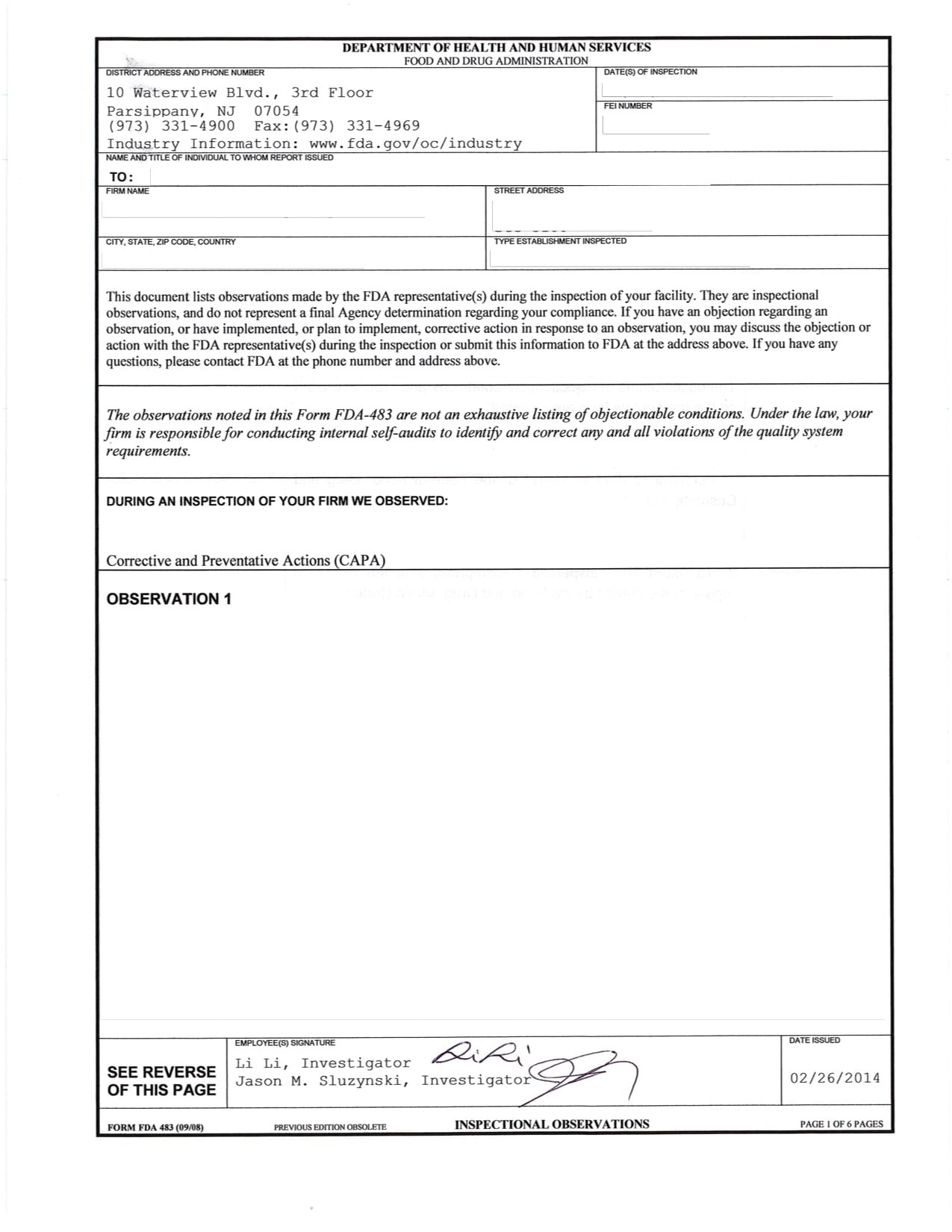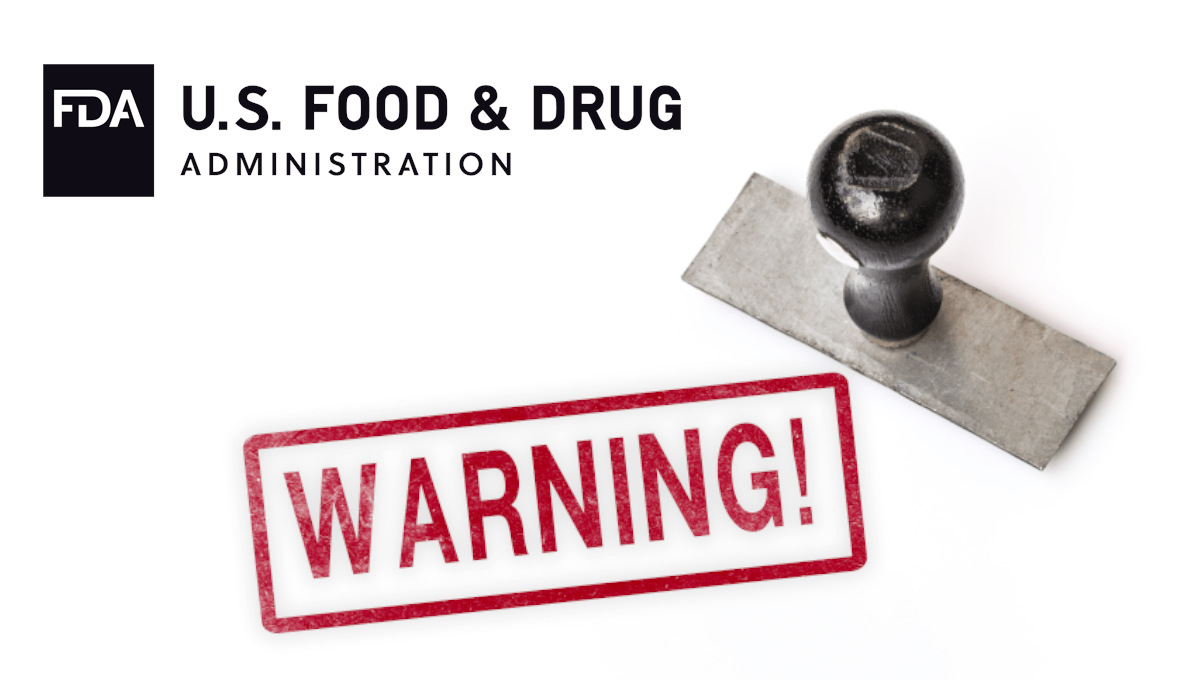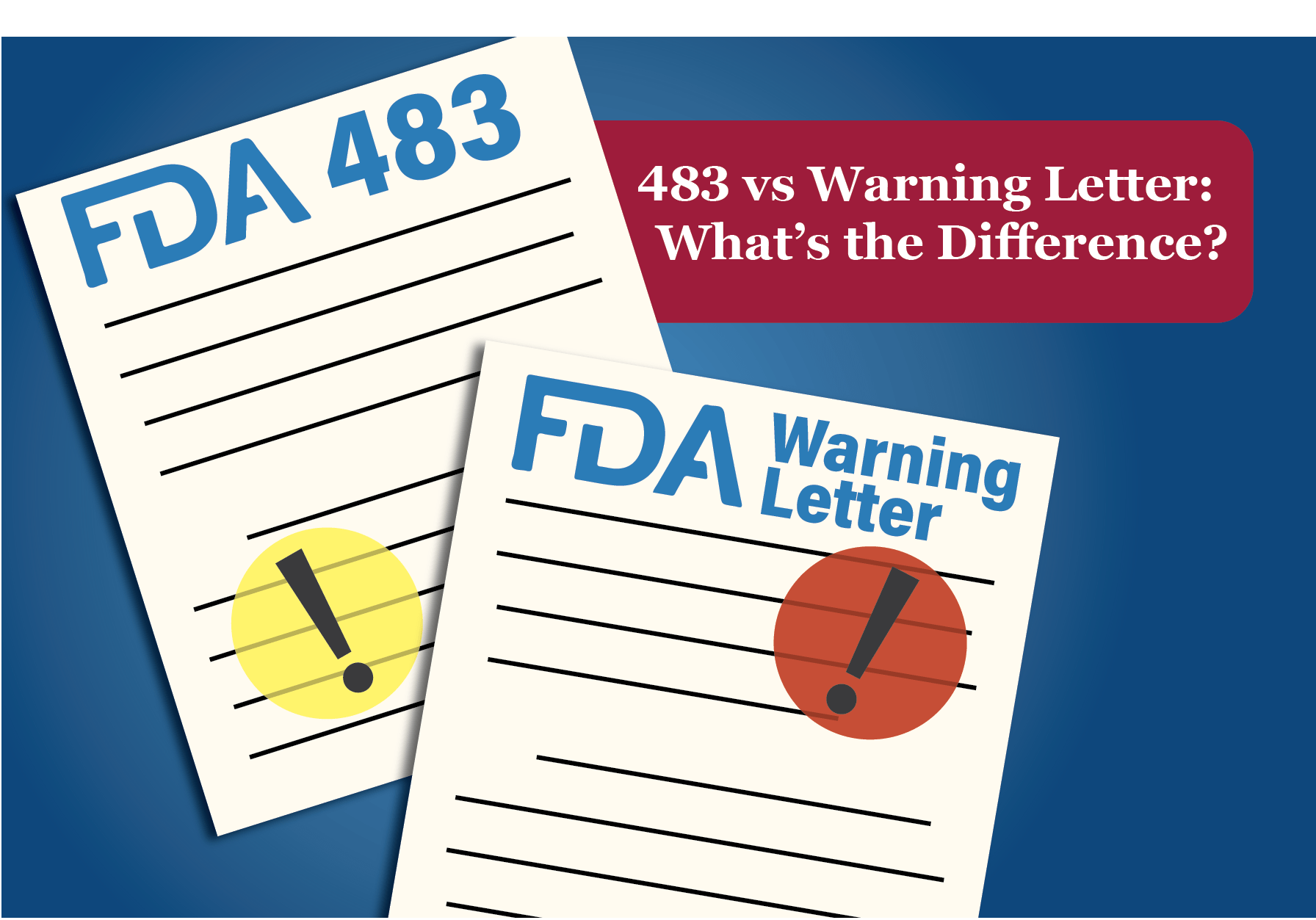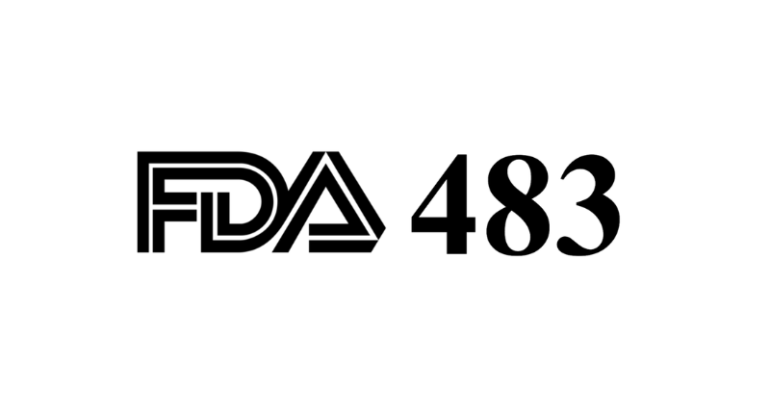What is FDA 483? Important Details About FDA 483 Forms
The FDA 483 form plays a crucial role in safeguarding consumer health by ensuring that products manufactured and circulated in the US market meet strict quality and safety standards. In this article, GOL will provide you with important information about the FDA 483 form, including its contents, issuance process, response methods, and consequences of non-compliance.
What is an FDA 483?
The FDA 483 is a form, which serves as a vital tool for documenting and communicating findings resulting from an FDA inspection of a medical device company’s manufacturing facility. When medical device companies that distribute products in the United States undergo inspections by the FDA to assess their compliance with the FDA Quality System Regulation (QSR), the conclusion of such inspections may involve the issuance of an FDA Form 483. This form is utilized when inspectors identify conditions during the inspection that violate provisions outlined in the Food, Drug, and Cosmetic Act.
Following the inspection, FDA investigators provide a comprehensive list of observations on the FDA Form 483, ensuring each item is clear, specific, and significant. Subsequently, the form is promptly shared and discussed with the management of the medical device company to ensure a thorough understanding of each observation by both the company and the investigator.

What is the purpose of an FDA Form 483?
The main objective of the FDA 483 is to alert companies to potential violations observed by FDA inspectors during inspections. Specifically, the FDA 483 aims to:
- Notify the company of issues identified by the FDA: The form itemizes the observations made by FDA inspectors that may indicate violations of FDA regulations.
- Require the company to take corrective action: The FDA expects the company to take specific steps to address the identified potential violations and prevent them from occurring in the future.
- Protect public health: By addressing potential violations, the FDA can help ensure that food, drugs, medical devices, and cosmetics are safe for consumers.
Additionally, the FDA 483 can also:
- Improve the company’s product quality: By addressing issues outlined in the form, the company can improve the quality of its products and manufacturing processes.
- Avoid additional legal enforcement actions: If the company fails to address potential violations adequately, the FDA may take legal enforcement actions, such as product recalls or criminal prosecution.
In summary, the FDA 483 is an important tool for the FDA to enforce its regulations and protect public health. By promptly and fully responding to the FDA 483, companies can address potential violations, improve product quality, and avoid further legal enforcement actions.
Impact of FDA 483 on manufacturing and storage facilities
An FDA 483 can have significant impacts on both manufacturing and storage facilities. Here’s a breakdown of the potential consequences:
Negative Impacts:
- Production Delays: Addressing the observations in an FDA 483 may require changes to procedures or equipment, potentially leading to production slowdowns or stoppages.
- Increased Costs: Implementing corrective actions can be expensive, involving new equipment, training programs, or additional personnel.
- Compliance Issues: A string of FDA 483s can raise concerns about a facility’s overall compliance with regulations, potentially leading to stricter future inspections.
- Product Recalls: Depending on the severity of the observations, the FDA may recommend a product recall if there’s a risk to consumer safety. This can significantly damage a company’s reputation and cause financial losses.
- Import/Export Restrictions: Facilities with unresolved 483 observations may face difficulties importing necessary materials or exporting finished products.
Positive Impacts (if addressed promptly):
- Improved Quality Control: Addressing the observations can lead to a more robust quality control system, minimizing the risk of future problems and product defects.
- Enhanced Safety: Resolving issues identified in an FDA 483 can ultimately improve safety standards within the facility, protecting both workers and consumers.
- Strengthened Compliance Culture: A prompt and effective response to an FDA 483 demonstrates a commitment to regulatory compliance, potentially fostering a more vigilant culture within the company.
Overall, the impact of an FDA 483 depends on the severity of the observations and the company’s response. By taking corrective actions seriously and working diligently to address the issues, facilities can minimize negative consequences and even turn the experience into an opportunity for improvement.

What should manufacturing facilities do when FDA issues a Form 483 after inspecting the facility?
When a manufacturing facility receives an FDA Form 483 following an inspection, it is crucial to respond promptly and effectively to address the observations made by the FDA inspectors. Here are some steps that manufacturing facilities should consider taking:
- Review the FDA Form 483: Thoroughly examine each observation listed on the FDA Form 483 to fully understand the areas of concern identified by the inspectors.
- Assess Compliance: Evaluate the facility’s current practices and procedures to determine the extent of compliance with FDA regulations and identify any gaps or deficiencies highlighted in the Form 483.
- Develop Corrective Action Plan: Develop a comprehensive corrective action plan (CAP) to address each observation listed on the FDA Form 483. The CAP should outline specific actions to be taken, responsible individuals or departments, timelines for implementation, and methods for verification and validation of corrective actions.
- Communicate with FDA: Open communication with the FDA is essential. If necessary, provide additional information or clarification to the FDA regarding the corrective actions being taken to address the observations outlined in the Form 483.
- Implement Corrective Actions: Implement the corrective actions outlined in the CAP within the specified timelines. Ensure that all personnel are trained on any new procedures or protocols implemented as part of the corrective actions.
- Document Everything: Maintain thorough documentation of all actions taken in response to the FDA Form 483, including the development and implementation of corrective actions, as well as any communication with the FDA.
- Follow-Up Inspection: If deemed necessary by the FDA, prepare for a follow-up inspection to demonstrate compliance with FDA regulations and the effectiveness of the corrective actions taken in response to the Form 483.
- Continuous Improvement: Use the observations outlined in the FDA Form 483 as an opportunity for continuous improvement. Regularly review and update procedures, protocols, and training programs to prevent recurrence of similar issues in the future.
By following these steps, manufacturing facilities can effectively address the findings of an FDA Form 483, demonstrate their commitment to compliance with FDA regulations, and maintain the integrity of their operations.
Differences between FDA Form 483 and Warning Letter
| Aspect | FDA Form 483 |
Warning Letter |
| Purpose | Notification of observed deficiencies | Formal communication of significant violations |
| Content | List of observations with no citations | Detailed violations with specific regulatory citations |
| Timing | Issued immediately after inspection | Issued after review of Form 483 and response |
| Regulatory Impact | Not a formal regulatory action | Official notification with regulatory implications |
| Implications | Indicates areas needing correction | Signals potential enforcement actions |
In summary, while both the FDA Form 483 and Warning Letter are tools used by the FDA to address compliance issues, the Warning Letter is a more formal and serious regulatory action that indicates significant violations and potential consequences for non-compliance, whereas the FDA Form 483 is a preliminary notification of observed deficiencies that provides an opportunity for corrective action.

FAQs about FDA Form 483
When is an FDA Form 483 issued?
An FDA investigator will issue a Form 483 at the conclusion of an inspection if they observe concerning conditions that could be violations.
How should a company respond to an FDA Form 483?
Companies should take an FDA Form 483 seriously and respond promptly (typically within 15 business days) with a written response that outlines:
- A detailed explanation for each observation.
- A specific corrective action plan for addressing each observation.
- Timelines for implementing the corrective actions.
What happens after a company responds to an FDA Form 483?
The FDA will review the company’s response. Depending on the severity of the observations and the adequacy of the response, the FDA may take various actions, including:
- No further action: This is the best outcome, indicating the FDA is satisfied with the response.
- Issuing a Warning Letter: This is a more formal notification of violations and requires a more detailed corrective action plan.
- Further enforcement actions: In severe cases, the FDA may pursue actions like product recalls or legal action.
Is FDA Form 483 a warning letter?
No, FDA Form 483 is not a warning letter. It is a document that outlines observations made during an inspection and provides an opportunity for the facility to address and correct the identified deficiencies before further regulatory action is taken.
What should a facility do upon receiving FDA Form 483?
Upon receiving FDA Form 483, the facility should carefully review the observations, assess compliance with FDA regulations, develop a corrective action plan to address the deficiencies, and communicate with the FDA to demonstrate efforts to achieve compliance.
How long does a facility have to respond to FDA Form 483?
There is no specific timeframe for responding to FDA Form 483. However, prompt and thorough response is recommended to demonstrate the facility’s commitment to addressing the identified deficiencies.
What are the consequences of receiving FDA Form 483?
While FDA Form 483 itself does not have direct regulatory consequences, failure to adequately address the identified deficiencies may lead to further enforcement actions by the FDA, such as warning letters, product recalls, fines, or injunctions.
Can FDA Form 483 observations be challenged or disputed?
Facilities can provide additional information or clarification to the FDA regarding the observations listed on FDA Form 483. However, challenging or disputing observations may require thorough documentation and justification.
How can facilities prevent receiving FDA Form 483?
Facilities can prevent receiving FDA Form 483 by proactively implementing and maintaining robust quality systems and procedures that comply with FDA regulations. Regular training, audits, and compliance monitoring can help identify and address potential issues before they become compliance problems during inspections.
Summary
Hopefully this article on the FDA Form 483 serves as a valuable resource for understanding its purpose, implications, and the necessary steps for addressing observations made during FDA inspections. By being informed about FDA Form 483 and its significance, regulated facilities can better navigate the regulatory landscape, prioritize compliance efforts, and ultimately ensure the safety and quality of their products for consumers.
If your company is seeking assistance with FDA registration and compliance, consider partnering with GOL, a trusted provider of regulatory services. Our team of experts offers comprehensive FDA registration services to help streamline the regulatory process and ensure compliance with FDA requirements. From initial registration to ongoing support, we are committed to guiding your company through every step of the FDA regulatory journey.
Contact us today to learn more about our FDA registration services and how we can assist your company in achieving regulatory compliance and success in the marketplace. Let GOL be your partner in navigating the complex world of FDA regulations and bringing your products to market with confidence.



